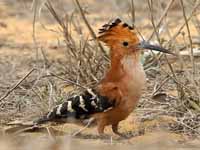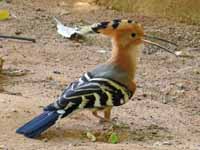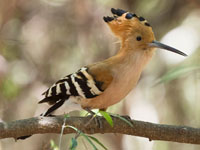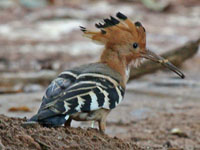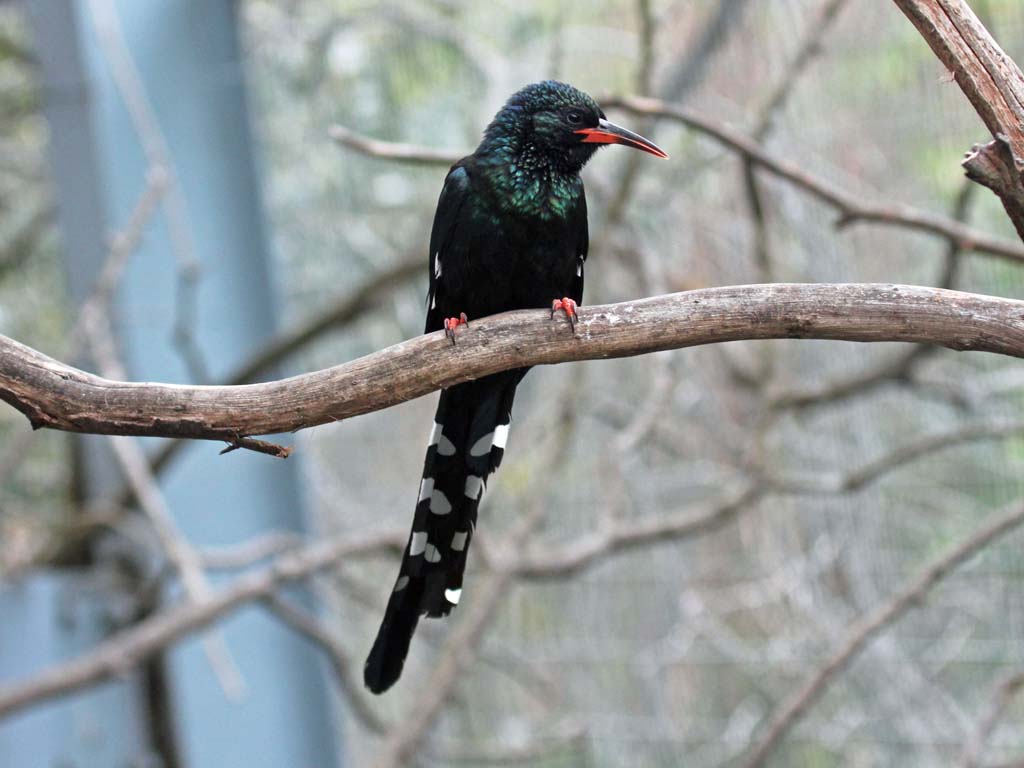THE WORLD BIRDS - An Online Bird Book
BUCEROTIFORMES
BUCEROTIFORMES
The order Bucerotiformes contains the hornbills, hoopoe and woodhoopoes. In addition to DNA comparisons, these three groups of birds have similar skulls and leg bones. However, the hornbills are very different in appearance and the current thought is that they have a different common ancestor from the hoopoes and woodhoopoes.
The Phoeniculidae family contains the woodhoopoes (also written as wood hoopoes) and the scimitar-bills. They both have long tails and long down-curved bills. However, the woodhoopoes and the scimitar-bills diverged about 10 million year ago and are thus distantly related. All family members are found in Sub-Sharan Africa and have a conservation status of Least Concern.
They have mainly dark blue, purple, or black plumage with the upperparts iridescent. Their length is from 23 to 46 cm with the woodhoopoes usually considerably larger than the scimitar-bills. They require large trees for nest cavities and also for roosting at night. As is true foor woodpeckers, these family members will often use theit tails for support while on tree trunks.
The woodhoopoes of genus Phoeniculus hop about branches looking for insects. The have three forward toes and one in the rear which differs from woodpeckers with their two forward toes and two in the rear. The woodpecker toe arrangement is better for climbing tree trunks than hopping on branches. The woodhoopoes are gregarious birds which gather in flocks.
The scimitar-bills of genus Rhinopomastus also have three foward toes and one in the rear. They are not gregarious, but are usually seen alone or in packs. In addition to foraging on tree trunks and branches, they will occasionally forage on the ground. On the ground they hop, instead of walking as do their close relative the hoopoes.
Genus Phoeniculus
Woodhoopoe,_Black-billed Phoeniculus somaliensis
Description: The black-billed woodhoopoe has mainly black plumage with a purple gloss. There is a row of white dots on the flight feathers.The bill is black. The black-billed woodhoopoe is up to 38 cm long. The similar green woodhoopoe has a red bill
Range: Sub-Saharan Africa.
Habitat: Woodlands, forest edges, scrubby areas.
Diet: Insects, spiders, millipedes.
Conservation status: Least Concern.
Image by: 1) Peter_Wilton - Ethiopia 2, 3, 4) Nik_Borrow - EthiopiaRange: Sub-Saharan Africa.
Habitat: Woodlands, forest edges, scrubby areas.
Diet: Insects, spiders, millipedes.
Conservation status: Least Concern.
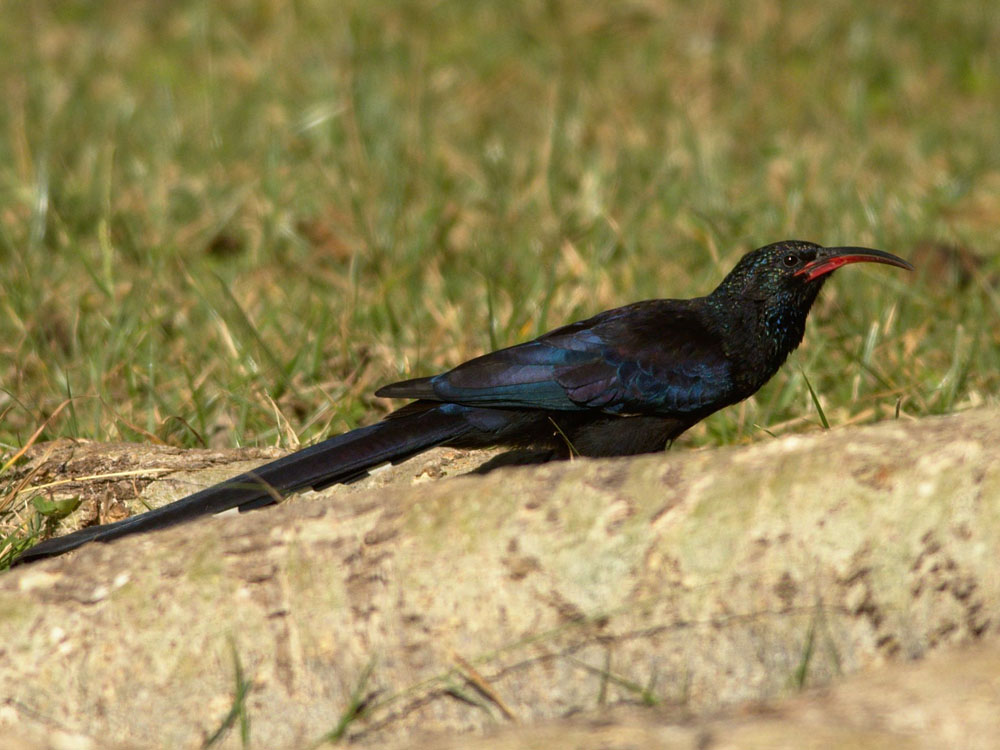
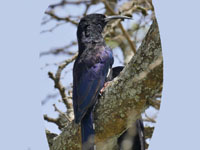

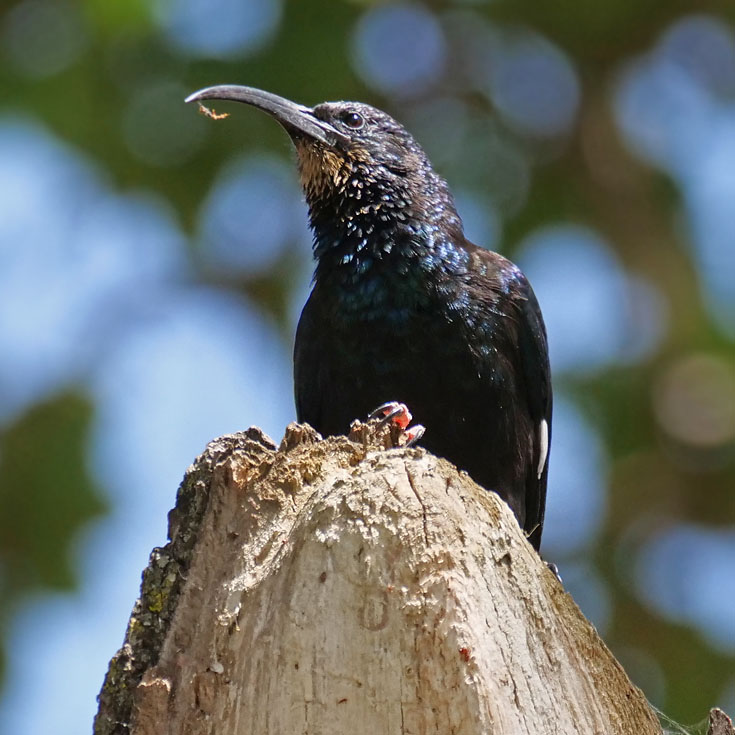
Woodhoopoe,_Forest Phoeniculus castaneiceps
Description: The forest woodhoopoe usually has a brown hood but can also have a whitish hood. The rest of the upperparts are iridescent greenish-blue. It has a dark lower-breast and belly. The legs and bill are red. The forest woodhoopoe is up to 28 cm long.
Range: Mainly west-central Africa.
Habitat: Forest; also other locals with tall trees.
Diet: Mainly insects, spiders; also fruits.
Conservation status: Least Concern.
Image by: 1) John_Gerrard_Keulemans 2) Nik_Borrow - UgandaRange: Mainly west-central Africa.
Habitat: Forest; also other locals with tall trees.
Diet: Mainly insects, spiders; also fruits.
Conservation status: Least Concern.
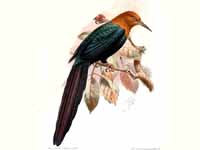
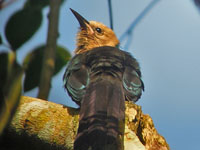
WoodHoopoe,_Green Phoeniculus purpureus
Description: The green woodhoopoe has metallic dark green plumage with a purple back. It has a long white-marked tail, a long curved red bill, and red legs. The similar black-billed woodhoopoe has a black bill. The green woodhoopoe is up to 40 cm long.
Range: Sub-Saharan Africa
Habitat: Woodlands with trees large enough for cavity nesting.
Diet: Insects, spiders, millipedes.
Conservation status: Least Concern.
Image by: 1) Dick - San Diego Zoo 2) Derek_Keats - South Africa 3) Jerry_Oldenettel - NamibiaRange: Sub-Saharan Africa
Habitat: Woodlands with trees large enough for cavity nesting.
Diet: Insects, spiders, millipedes.
Conservation status: Least Concern.

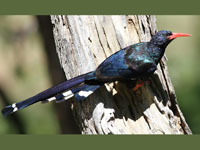
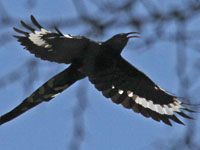
Woodhoopoe,_Violet Phoeniculus damarensis
Description: The violet woodhoopoe has dark purple iridescence on its upperparts. It has a blue-green chin and throat. The underparts are similar to the upperparts, but without iridescence. It has a red bill and feet. The under-tail has white tips. The violet woodhoopoe is up to 38 cm long. The similar black-billed woodhoopoe has a black bill.
Range: Angola, Kenya, Namibia, Tanzania.
Habitat: Dry bushland; also palm trees.
Diet: Mainly insects. Will eat small bird eggs whole.
Conservation status: Least Concern.
Image by: 1) Herbert_Goodchild 2) Ian_White - Angola 3) Jerry_Oldenettel - NamibiaRange: Angola, Kenya, Namibia, Tanzania.
Habitat: Dry bushland; also palm trees.
Diet: Mainly insects. Will eat small bird eggs whole.
Conservation status: Least Concern.
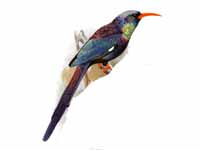
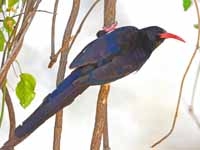
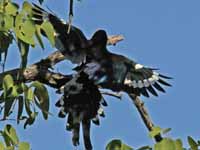
Woodhoopoe,_White-headed Phoeniculus bollei
Description: The white-headed woodhoopoe has dark blue iridescent upperparts including the rear-crown and nape. The rest of the head and thoat are off-white. The slightly down-curved bill and legs are red. The underparts are dark blue. The white-headed woodhoopoe is up to 35 cm long.
Range: East-central Africa.
Habitat: Varied from dry savanna to montane forests.
Diet: Insects, spiders; also berries, seeds.
Conservation status: Least Concern.
Image by: 1) John_Gerrard_Keulemans 2) Nik_Borrow - Uganda 3) Peter_Steward - UgandaRange: East-central Africa.
Habitat: Varied from dry savanna to montane forests.
Diet: Insects, spiders; also berries, seeds.
Conservation status: Least Concern.
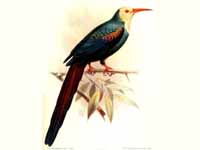

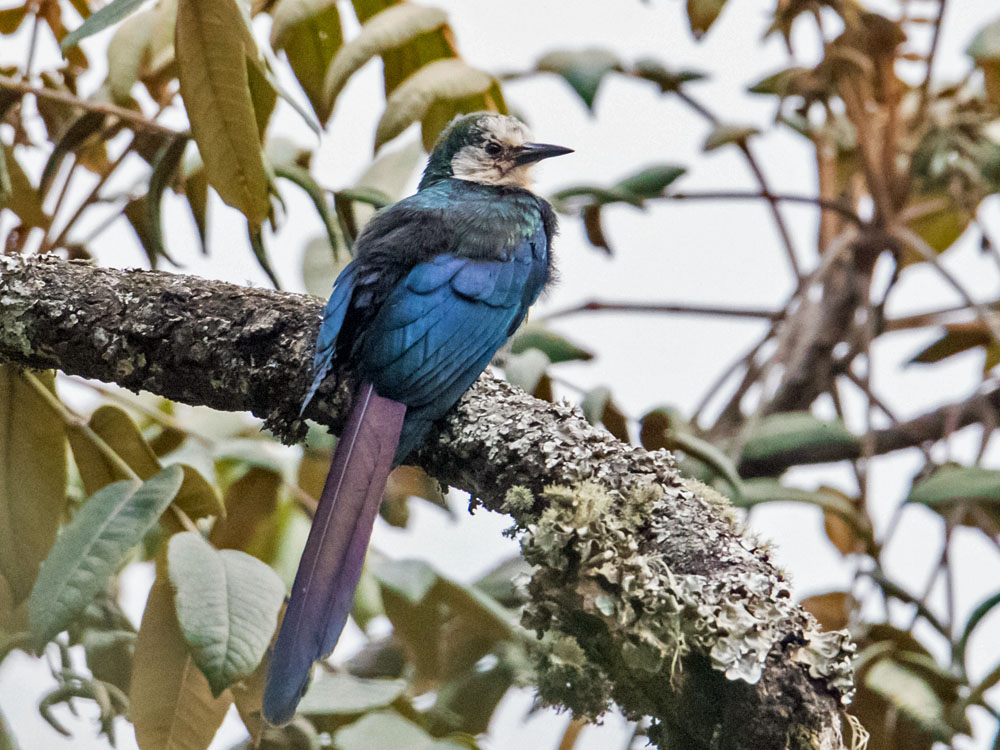
Genus Rhinopomastus
They are smaller than most woodhoopoes and 2 out of the three species have their bills strongly curved like a scimitar, giving them their name. They mainly forage on tree trunks and branches, but also occasionally on the ground. They are mostly glossy black in color with a few white markings on the wings. While other woodhoopoes are gregarious birds and gather in flocks, the scimitarbills are usually seen alone or in pairs.
Scimitar-bill,_Abyssinian Rhinopomastus minor
Description: The Abyssinian scimitar-bill has black plumage with a purple iridescence to the upperparts. Its orange bill is deeply curved; the legs are black. The Abyssinian scimitar-bill is up to 24 cm long which makes it the one of the smallest member of the family.
Range: Djibouti, Ethiopia, Kenya, Somalia, South Sudan, Tanzania, Uganda.
Habitat: Areas with scattered trees, not dense forests.
Diet: Mainly insects; also fruits, berries.
Conservation status: Least Concern.
Image by: 1) Nik_Borrow -Ethiopia 2, 3) Peter_Steward - NairobiRange: Djibouti, Ethiopia, Kenya, Somalia, South Sudan, Tanzania, Uganda.
Habitat: Areas with scattered trees, not dense forests.
Diet: Mainly insects; also fruits, berries.
Conservation status: Least Concern.
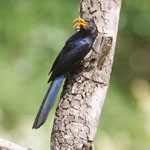
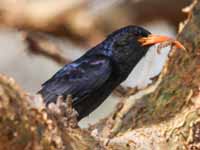

Scimitar-bill,_Black Rhinopomastus aterrimus
Description: The black scimitar-bill has black plumage with a purple gloss. It has a white wing-bar. The black bill is almost straight, raising the question why it is called a scimitar-bill. The black scimitar-bill is up to 23 cm long; it is this small size that differentiates it from the larger woodhoopoes.
Range: Mainly in central Africa.
Habitat: Areas with scattered trees, not dense forests.
Diet: Mainly insects, spiders; also berries.
Conservation status: Least Concern.
Image by: 1) Francesco_Veronesi - GambiaRange: Mainly in central Africa.
Habitat: Areas with scattered trees, not dense forests.
Diet: Mainly insects, spiders; also berries.
Conservation status: Least Concern.

Scimitar-bill,_Common Rhinopomastus cyanomelas
Description: The common scimitar-bill has iridescent blue plumage with some white on the wings and a varying amount of white on the tail. The black bill is extremely curved. The common scimitar-bill is the largest of the scimitar-bills, up to 30 cm long.
Range: Southern Africa.
Habitat: Areas with scattered trees, not dense forests.
Diet: Mainly insects, spiders. Also fruits, berries, and some seeds.
Conservation status: Least Concern.
Image by: 1)
Yathin_Krishnappa 2) Steve_Garvie 3) Ian_White - Zimbabwe 4) Lip_kee - BotswanaRange: Southern Africa.
Habitat: Areas with scattered trees, not dense forests.
Diet: Mainly insects, spiders. Also fruits, berries, and some seeds.
Conservation status: Least Concern.
1) Juvenile

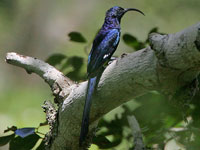
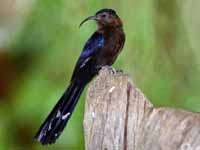
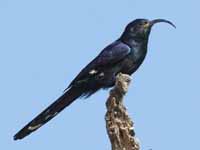
Genus Upupa
Hoopoe, Eurasain Upupa epops
Description: The Eurasian hoopoe, also known as the hoopoe, has an orange head and upper-mantle. The lower mantle and wings are black and white. In addition to that identifying feature, it has an amazing crest that has a black and white tip. It has a long thin bill that is slightly down-cuved. The call is oop-oop-opp from which comes the name.
The African Hoopoe is now considered to be a subspecies, U. e. africana, not a separated species.
Range: Europe, Asia, Africa.
Habitat: Open land such as lawns and near trees with cavities for nesting.
Diet: Mainly insects; also berries, seeds, and small reptiles.
Conservation status: Least Concern.
Image by: 1) Imran_Shah - Pakistan 2) Dick Daniels - Fish Eagle Lodge, Knysna Lagoon 3) J.
M. Garg 4) Andy_Morffew - HungaryRange: Europe, Asia, Africa.
Habitat: Open land such as lawns and near trees with cavities for nesting.
Diet: Mainly insects; also berries, seeds, and small reptiles.
Conservation status: Least Concern.
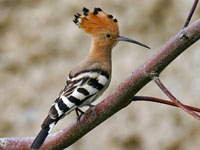

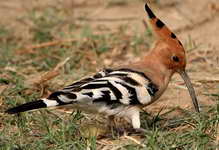

Hoopoe,_Madagascar Upupa marginata
Description: The Madagascar Hoopoe is very similar to the Upupa epops Hoopoe and is consider by some to be a subspecies. It does have different vocalizations.
Range: Madagascar.
Habitat: Open land such as lawns and near trees with cavities for nesting.
Diet: Mainly insects; also berries, seeds, and small reptiles.
Conservation status: Least Concern.
Image by: 1) David Cook 2) Pat and Keith Taylor - Ankarafantsika National Park 3) Alan_Harper 4) Jerry_OldenettelRange: Madagascar.
Habitat: Open land such as lawns and near trees with cavities for nesting.
Diet: Mainly insects; also berries, seeds, and small reptiles.
Conservation status: Least Concern.
